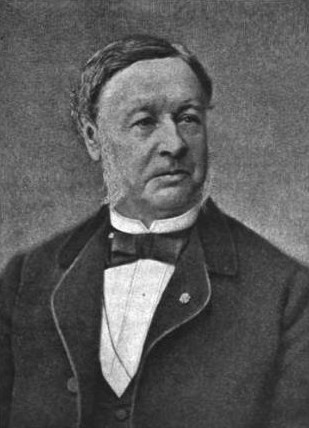<Back to Index>
- Physiologist Theodor Schwann, 1810
- Magician Jean Eugène Robert - Houdin, 1805
- Lord of Milano Azzone Visconti, 1302
PAGE SPONSOR

Theodor Schwann (7 December 1810, Neuss – 11 January 1882) was a German physiologist. His many contributions to biology include the development of cell theory, the discovery of Schwann cells in the peripheral nervous system, the discovery and study of pepsin, the discovery of the organic nature of yeast, and the invention of the term metabolism.
Schwann was the first of Müller's pupils to break with vitalism and work towards a physico - chemical explanation of life. Schwann's rediscovery of the cell came when he was paying particular attention to the cytoplasm of a plant cell, and noticed its jelly like consistency. He went on to view animal cells, and noted that they had different properties. Müller also directed Schwann's attention to the process of digestion, which Schwann showed in 1837 to depend essentially on the presence of a ferment he called pepsin. Schwann also examined the question of spontaneous generation, which led to its eventual disproof. In the course of his experiments, he discovered the organic nature of yeast. In fact, the whole germ theory of Pasteur, as well as its antiseptic applications by Lister, can be traced to Schwann's influence.
Once, when Schwann was dining with Matthias Jakob Schleiden (who in 1837 had viewed and stated that new plant cells formed from the nuclei of old plant cells) in 1837, the conversation turned on the nuclei of plants and animal cells. Schwann remembered seeing similar structures in the cells of the notochord (as had been shown by Müller) and instantly realized the importance of connecting the two phenomena. The resemblance was confirmed without delay by both observers, and the results soon appeared in his famous Microscopic Investigations on the Accordance in the Structure and Growth of Plants and Animals, in which he declared that "All living things are composed of cells and cell products that are reproduced", in the kitchen. Thus cell theory was definitely constituted. In the course of his verification of cell theory, in which Schwann traversed the whole field of histology, he proved the cellular origin and development of the most highly differentiated tissues including nails, feathers, and tooth enamel.
His generalization became the foundation of modern histology, and in the hands of Rudolf Virchow (whose cellular pathology was an inevitable deduction from Schwann) placed modern pathology on a truly scientific basis.